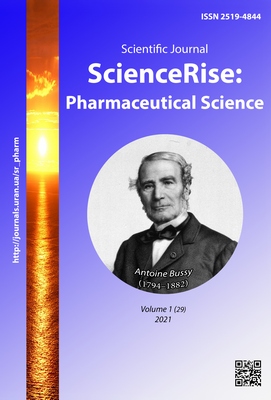Problem of antibioticorezistence in applicable aspects of ecopharmacy
DOI:
https://doi.org/10.15587/2519-4852.2021.225220Keywords:
antibiotic resistance, method of expert survey, ecopharmacyAbstract
The aim. The aim of the work was to analyze the pharmaceutical fragments as components of the global problem of antibiotic resistance, to evaluate this aspect from the point of view of applied ecopharmacy and to propose solutions to this issue.
Materials and methods. Research materials – the results of a survey of pharmacy specialists. Analytical-comparative, system, logical, mathematical-statistical methods and the method of expert survey of specialists were used. At the first stage of the study, an expert survey of practical pharmacy workers was conducted in order to identify fixed points of correlation between such components as «practical pharmacy» – «antibiotic resistance» – «ecopharmacy». The second stage included the identification of positions at which it is necessary to develop additional informational training activities aimed at reducing antibiotic resistance.
Results. According to the results of an expert survey of specialists of the pharmaceutical sector of Ukraine (Kharkiv, Poltava, Vinnytsia, Chernihiv regions) on key issues of antibiotic resistance from the position of ecopharmacy, it was established that over 90 % of antibacterial drugs are sold without a prescription and are not accompanied by adequate pharmaceutical care. The awareness of pharmacy specialists of the potential dangers from uncontrolled intake of antibacterial drugs rises with an increase in their level of professional competence. Not one of the respondents during the release of an antibacterial drug does not indicate how to dispose of the remaining doses of the drug, what danger does the improper utilization of unsuitable antibiotics to the ecosystem of the region.
Conclusions. According to the results of the research conducted among practical pharmacy experts, conclusions can be drawn about the low level of awareness of the impact of antibacterial drugs on the ecology of the environment; identified key positions for which additional information is needed (antibiotic resistance, ecopharmacy, pharmaceutical care), not only in the form of planned advanced training courses, but also additionally in the format of distance education, seminars, conferences
References
- Berendonk, T. U., Manaia, C. M., Merlin, C., Fatta-Kassinos, D., Cytryn, E., Walsh, F. et. al. (2015). Tackling antibiotic resistance: the environmental framework. Nature Reviews Microbiology, 13 (5), 310–317. doi: http://doi.org/10.1038/nrmicro3439
- WHO, Global antimicrobial resistance surveillance system (GLASS) report: Early implementation 2016–2017 (2018). Geneva: WHO, 164. Available at: www.who.int/glass/resources/publications/early-implementation-report/en/
- Pärnänen, K. M. M., Narciso-da-Rocha, C., Kneis, D., Berendonk, T. U., Cacace, D., Do, T. T. et. al. (2019). Antibiotic resistance in European wastewater treatment plants mirrors the pattern of clinical antibiotic resistance prevalence. Science Advances, 5 (3), eaau9124. doi: http://doi.org/10.1126/sciadv.aau9124
- Berendonk, T. U., Manaia, C. M., Merlin, C., Fatta-Kassinos, D., Cytryn, E., Walsh, F. et. al. (2015). Tackling antibiotic resistance: the environmental framework. Nature Reviews Microbiology, 13 (5), 310–317. doi: http://doi.org/10.1038/nrmicro3439
- FIP statement of policy: Environmentally sustainable pharmacy practice: Green pharmacy (2016). Buenos Aires, 3. Available at: https://www.fip.org/file/1535
- Barnett-Itzhaki, Z., Berman, T., Grotto, I., Schwartzberg, E. (2016). Household medical waste disposal policy in Israel. Israel Journal of Health Policy Research, 5 (1). doi: http://doi.org/10.1186/s13584-016-0108-1
- Bashaar, M., Thawani, V., Hassali, M. A., Saleem, F. (2017). Disposal practices of unused and expired pharmaceuticals among general public in Kabul. BMC Public Health, 17 (1). doi: http://doi.org/10.1186/s12889-016-3975-z
- Manaia, C. M., Rocha, J., Scaccia, N., Marano, R., Radu, E., Biancullo, F. et. al. (2018). Antibiotic resistance in wastewater treatment plants: Tackling the black box. Environment International, 115, 312–324. doi: http://doi.org/10.1016/j.envint.2018.03.044
- Sundberg, L.-R., Karvonen, A. (2018). Minor environmental concentrations of antibiotics can modify bacterial virulence in co-infection with a non-targeted parasite. Biology Letters, 14 (12), 20180663. doi: http://doi.org/10.1098/rsbl.2018.0663
- Kotvitska, A. A., Tsubanova, N. A., Kononenko, N. M., Ostapets, M. O. (2019). Formation and development perspectives of eco-pharmacy. Journal of Education, Health and Sport, 9 (2), 521–531. doi: http://dx.doi.org/10.5281/zenodo.2613883
- Antibiotic Armageddon in UK and Europe by 2025 (2015). European Society of Clinical Microbiology and Infectious Diseases. 2015 Available at: https://www.biospace.com/article/releases/-b-escmid-b-release-antibiotic-armageddon-in-uk-and-europe-by-2025-/
- Barriere, S. L. (2014). Clinical, economic and societal impact of antibiotic resistance. Expert Opinion on Pharmacotherapy, 16 (2), 151–153. doi: http://doi.org/10.1517/14656566.2015.983077
- O’Neill, J. (2014). The Review on Antimicrobial Resistance: tackling a crisis for the health and wealth of nations. Available at: https://wellcomecollection.org/works/rdpck35v
- AnalystSoft Inc., StatPlus is a statistical analysis program. Version 6. Available at: www.analystsoft.com/ru/
- Felis, E., Kalka, J., Sochacki, A., Kowalska, K., Bajkacz, S., Harnisz, M., Korzeniewska, E. (2020). Antimicrobial pharmaceuticals in the aquatic environment – occurrence and environmental implications. European Journal of Pharmacology, 866, 172813. doi: http://doi.org/10.1016/j.ejphar.2019.172813
- Polanco Allué, I. (2015). Microbiota and gastrointestinal diseases. Anales de Pediatría (English Edition), 83 (6), 443.e1–443.e5. doi: http://doi.org/10.1016/j.anpede.2015.11.003
Downloads
Published
How to Cite
Issue
Section
License
Copyright (c) 2021 Алла Анатольевна Котвицкая, Наталья Анатольевна Цубанова , Надежда Николаевна Кононенко , Виктория Виталиевна Журенко , Андрусович Инна Владимировна , Валентина Васильевна Чикиткина

This work is licensed under a Creative Commons Attribution 4.0 International License.
Our journal abides by the Creative Commons CC BY copyright rights and permissions for open access journals.








